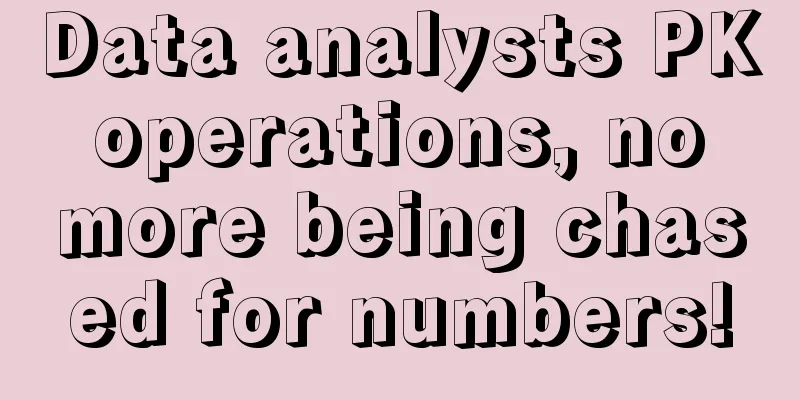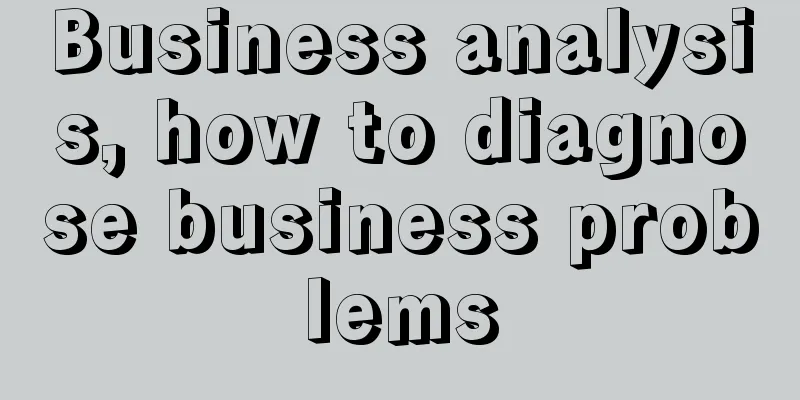Data analysts PK operations, no more being chased for numbers!

What data analysts fear the most must be the endless demand for data collection. This time, facing this demand scenario, we went from being passive to being active, and used data analysis to support operations. Let’s get straight to the point and get started! Problem scenario: An e-commerce company recently discovered through data that a large number of users added items to the shopping cart but did not pay (abbreviated as: added to cart but not purchased). The operation has started to work on this situation, but the leaders are not satisfied and require the data analysis team to analyze the added to cart but not purchased customer group through the user portrait model to increase the payment ratio. Suppose you are a data analyst of the company, ask... Question 1: You are a data analyst, what is the first thing you do?
Question 2: What are the needs of the leader in this scenario?
Question 3: When you buy something on a website, which of the following will most make you decide to pay?
1. Operation Optimization Project80% of the reasons why data analysis is useless are because it is divorced from reality and done behind closed doors. The root cause of this is that people who work on data are too obsessed with the data itself and forget what they are really doing. For example, in this case scenario, if you ask the above three questions, even a fool will understand:
So the first thing to do is to talk to the operator about these:
Communication skills are also important here. Note that in this scenario, the leaders’ dissatisfaction is already evident on their faces. At this time, you must firmly show to the operations team: “I am working with you to find a solution, and we will complete this task together.” This is the only way to gain more support. If you act like "I'm awesome and you're all stupid", then just expect to be constrained by others and end up in disgrace. 2. The second key issueQuestion 4: After learning about it, I found that the current practice of the operation is to give out coupons based on 10% of the amount added to the shopping cart, for example, 10 yuan for a 100 yuan item and 20 yuan for a 200 yuan item. After learning this, what will you do...
Question 5: How would you prove that you have had a positive impact on the problem of added-to-cart items?
Question 6: Which of the following situations can prove that the new strategy has produced results (as shown below) 3. BreakthroughThe general psychology of people is: the longer you wait, the higher your expectations. Especially when you are already anxious, you hope to see results quickly. So in this scenario, user portraits, models, and reports are all correct, but the first thing to consider is: how long does it take to take effect? The sooner the effect, the better. At the same time, the simpler the method, the better. Because the more complicated the method, the fewer people can participate, which means that you will have to bear the greater blame. For example, the "super-accurate purchase model" is incomprehensible to anyone except the data maker. If the effect is not good in the end, the data maker will be the only one to bear the blame. This involves the question of "how many lines of code do I need to write to make customers buy?" In short, don't rely on code, work side by side with operations, and give priority to coupons. Many students may think it's difficult to do after hearing: the effect is fast and good. Note that "effectiveness" here can have several effects. Using the simplest concept of input-output ratio, reducing input, increasing output, and improving the ratio are all considered effective. Therefore, from the beginning, do not set the goal of completely solving the problem, but to continuously optimize the effect. This will make it easier to get things done and continue to see results. After sorting it out like this, the idea becomes much clearer: the current blanket distribution of coupons is a very rough practice. The profit margins of different commodities are different. Such a simple and rough discount is likely to severely compress gross profits and even produce products with negative gross profits. At the same time, some products are approaching their expiration dates, so more profits can be released to clear the stock. Some products have high profits and have room to release more profits. After this sorting out, the actions for the first phase are very clear (as shown below): 4. Iteration and continuous optimizationQuestion 7: Which of the following two options should you do first?
Note that in this scenario, the leaders are already dissatisfied and have contacted external departments. In this case, if you say "We need to invest an additional XXX million", either the leaders will be criticized or their expectations will be raised even higher, thinking that the additional investment will have an invincible effect. Both of these situations are digging a hole for yourself! So it is best to start from the perspective of cutting costs. First, cut a subsidy with obvious negative output to release marketing expenses; then make some near-expiry products and clear inventory products; then use the released expenses to subsidize high-profit products to increase the conversion rate of add-to-cart. After that, you can continue to iterate. For example, if the conversion rate of high-profit products has been improved, you can do a price elasticity test, reduce subsidies appropriately, and release another wave of marketing expenses. If the single product is almost done, you can use the released profits to do full discounts or cross-selling. These are just pure price manipulation. The data calculation is easy and effective. After all, the coupons are real money. This will not only be effective, but also last a long time. Piloting every month, iterating four or five times, can at least last half a year. This precious half year can be used to accumulate data for "AI algorithm recommendation" and "big data user portrait insight", and also buy enough time to train the model. When the price is about the same, you can continue to play, the effect will continue to improve, and everyone will be happy. It is much better than holding back on the big move at the beginning, holding it back for half a year and then not using it, and not leaving in disgrace (as shown below). Some students may ask: In this scenario, the operation first provides comprehensive subsidies and then optimizes, so there is room for cost reduction. If the operation only pilots a small group and fails and needs to be optimized, what should be done? This is a good question, especially when conducting a small-scale MVP test, the sample size is small and there is a need to analyze various situations. What should we do? Author: Down-to-earth Teacher Chen Source: WeChat public account "Down-to-earth Teacher Chen (ID: gh_abf29df6ada8)" |
<<: Businessmen who make a living on WeChat are turning to short videos
>>: Can Video Account bring new ideas to live streaming e-commerce?
Recommend
A wave of copywriting standing in the atmosphere
The author of this article shares British Airways’...
The popular short drama about tourism and culture is still waiting for a hit
Short dramas have been very popular recently. They...
What to do if Amazon orders suddenly drop? How to increase sales?
There are some differences between the Amazon plat...
How long does it take for eBay to stop posting comments? How to choose products?
There are actually quite a lot of merchants openin...
Why do iQiyi, Youku, Tencent Video and Mango TV have to make short dramas?
After the short drama became popular, many compani...
I didn’t realize that I was working with the analyst incorrectly. Only when I used the right method did my business grow.
How can you solve these current confusions if you ...
Writing copy? The informal kind
In this article, the author introduces four specia...
Does Shopee have traffic for newly launched products? How to increase traffic?
One of the important things when opening a store o...
What is the difference between eBay China and Taobao? A must-read for cross-border merchants
eBay China and Taobao are two very well-known plat...
How to set up three variations on Amazon? What is the method?
When opening a store and promoting on Amazon, you ...
What is Marketing Automation MA? How to build a good marketing automation system
The concept of marketing automation has only becom...
What is the interview process for Shopee Singapore? Will there be a rejection letter during the Shopee interview?
As the headquarters of Shopee, Singapore's int...
How to optimize Shopee store? What are the benefits?
Every day, many merchants open stores on Shopee. T...
Fight against counterfeiting and quit the Internet, does this era no longer need big anchors?
The live streaming industry has been booming in re...
How to add Amazon variations? What is the method?
When opening a store on Amazon, many people will b...









